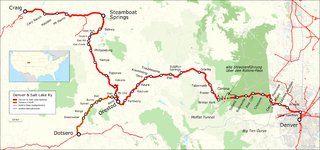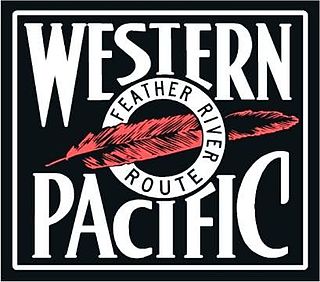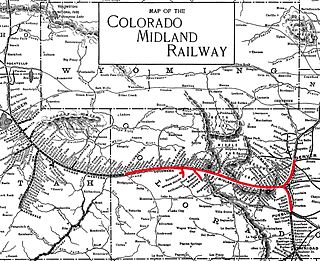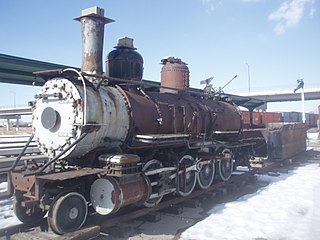
Wilson McCarthy (24 July 24, 1884 - 1956) was an American attorney, jurist and railroad executive.

Wilson McCarthy (24 July 24, 1884 - 1956) was an American attorney, jurist and railroad executive.
According to author Will Bagley, McCarthy's grandfather immigrated to the United States from Ireland circa 1847 in the midst of the Great Famine. McCarthy's father Charles, born in Ohio in 1850, traveled to Utah, where he became a stage coach driver. He converted to the Church of Jesus Christ of Latter-day Saints when he married Mary Mercer in 1876. Mary Wilson failed to conceive, so Charles took her sister as a second wife, later going to prison as a polygamist. Ironically, Mary Wilson then gave birth to two sons in quick succession, the second being Warren Wilson McCarthy. McCarthy was born in American Fork, Utah on July 24, 1884. The family emigrated to Alberta, Canada, where McCarthy grew up as a ranch hand and cowboy. Boots and western wear became the "standard attire for the rest of his life."[ citation needed ]
Denver novelist Sandra Dallas notes McCarthy was a colorful character in more ways than just his attire. "He accused his predecessor of having 'cracked ice pumping through your veins.' And he apparently was not as strait-laced as his Latter-day Saint upbringing might suggest, because he once invited his son to meet his mistress."
Wilson served a mission for the Church of Jesus Christ of Latter-day Saints to his family's ancestral land of Ireland. Upon returning to the United States, however, he gave up on his cowboy lifestyle, marrying Minerva Woolley in 1910, moving to New York City and entering law school at Columbia University.
After obtaining his law degree, Wilson returned to Utah, where he entered politics in the Democratic Party, worked as a district attorney, and was ultimately appointed to a judgeship on Utah's Third District Court in 1919. He left the bench in barely a year, going on to earn a sizable fortune in private practice. In 1926 he was elected to the state senate. In the wake of the Wall Street Crash of 1929, he was appointed by Republican President Herbert Hoover to the Reconstruction Finance Corporation in 1932, even though McCarthy was a Democrat. Again, he served scarcely a year, this time leaving politics for a career in banking in San Francisco, California.
In 1934, RFC Chairman Jesse H. Jones asked McCarthy to take control of the Denver and Rio Grande Western Railroad, which had just defaulted on a $10 million loan. The Rio Grande was back in court the following year, petitioning for reorganization under the Federal Bankruptcy Act. U.S. District Court Judge John Foster Symes appointed Denver's Henry Swan and McCarthy co-trustees. Thus began a two decade odyssey for McCarthy, the ultimate beneficiary being a rehabilitated Rio Grande.
Despite its inability to pay interest on $122 million in debt, McCarthy and Swan worked to repair and rebuild the Rio Grande. In 1937 alone the two pumped $18 million into the property. Under McCarthy's administration, the Rio Grande built over 1,130 bridges and laid over two million ties. At one point during the Great Depression, the Rio Grande spent one million dollars a year for five years running. The road also bought its first new motive power in over ten years. By 1940 the McCarthy receivership spent over $20 million upgrading the Rio Grande. By the end of World War II, the Rio Grande's revenues increased from $17 million to $75 million per year. In 1942 alone, revenues increased by a staggering 905 percent.
At the same time, the Rio Grande moved to trim or eliminate its fabled narrow gauge system. In conjunction with the Chicago, Burlington and Quincy Railroad it built the Dotsero Cut-Off (completed 1935). The Salt Lake and Denver and its vital Moffat Tunnel line (completed 1927) were absorbed, anchoring the Rio Grande between Salt Lake City, Utah, and Denver, Colorado. This allowed the Rio Grande to cut its freight time between these two points from 54 to under 24 hours.
Again working with Ralph Budd of the Burlington, McCarthy, in conjunction with the Western Pacific Railroad, began the streamlined California Zephyr service between Chicago, Illinois, and the Bay Area. During McCarthy's tenure the train's signature vista-dome cars were added.
Civically minded, McCarthy worked to help bring Geneva Steel to Utah, promoted stock shows in Colorado, and served on the planning commission celebrating the centennial of the arrival of Mormon pioneers in Salt Lake in 1947.
In 1947 the Rio Grande emerged from the co-trusteeship. The Interstate Commerce Commission approved a reorganization plan. Though opposed to the U.S. Supreme Court by both the Missouri Pacific Railroad and the Western Pacific Railroad, the reorganization committee elected a new board of directors, naming John Evans chairman and McCarthy president. (The MP and WP controlled the Rio Grande for a period beginning October 29, 1924, under the planning of George J. Gould and Benjamin Franklin Bush.)
Though passenger traffic waned in the wake of World War II, McCarthy's efforts to develop agriculture and industry along the Rio Grande's routes paid off in heavier traffic loads and increased receipts. He died in 1956 and was succeeded by Gale B. Aydelott, president of the Rio Grande through 1977.
McCarthy married Minerva Woolley on June 22, 1910. They had five children together. McCarthy suffered a stroke while in Washington, D.C., and he died at Holy Cross Hospital in 1956. His funeral was presided over by The Church of Jesus Christ of Latter-day Saints President David O. McKay. On the day of his funeral, every Rio Grande train stopped at 11 a.m. and their crews observed two minutes of silence.
After his death, the Rio Grande renamed their business car No. 100 as the Wilson McCarthy. (The car was renamed Kansas when the Rio Grande absorbed the Southern Pacific circa January, 1986.)

The Denver and Rio Grande Western Railroad, often shortened to Rio Grande, D&RG or D&RGW, formerly the Denver & Rio Grande Railroad, was an American Class I railroad company. The railroad started as a 3 ft narrow-gauge line running south from Denver, Colorado, in 1870. It served mainly as a transcontinental bridge line between Denver, and Salt Lake City, Utah. The Rio Grande was also a major origin of coal and mineral traffic.

The California Zephyr was a passenger train that ran between Chicago, Illinois and Oakland, California via Omaha, Denver, Salt Lake City, Winnemucca, Oroville and Pleasanton. It was operated by the Chicago, Burlington & Quincy (CB&Q), Denver & Rio Grande Western (D&RGW) and Western Pacific (WP) railroads, all of which dubbed it "the most talked about train in America" on March 19, 1949, with the first departure the following day. The train was scheduled to pass through the most spectacular scenery on its route in the daylight. The original train ceased operation in 1970, though the D&RGW continued to operate its own passenger service, the Rio Grande Zephyr, between Salt Lake City and Denver, using the original equipment until 1983. In 1983 a second iteration of the California Zephyr, an Amtrak service, was formed. The current version of the California Zephyr operates partially over the route of the original Zephyr and partially over the route of its former rival, the City of San Francisco.

The Denver and Salt Lake Railway (D&SL) was a U.S. railroad company located in Colorado. Originally incorporated in 1902 as the Denver, Northwestern and Pacific (DN&P) Railway, it had as a goal a direct connection of Denver, Colorado, with Salt Lake City, Utah. It underwent numerous reorganizations throughout its financially troubled history and by the time the company was acquired in 1931 by the Denver and Rio Grande Western Railroad, it had advanced only as far as Craig, Colorado. After the acquisition the line was connected to the D&RGW main, and the eastern half of the line was used to give the D&RGW a more direct route to Denver. The portions of the railroad still in use today are known as the Moffat Tunnel Subdivision of Union Pacific Railroad's Central Corridor. Amtrak’s California Zephyr service from Denver to Glenwood Springs follows much of the old D&SL route.

The Western Pacific Railroad was a Class I railroad in the United States. It was formed in 1903 as an attempt to break the near-monopoly the Southern Pacific Railroad had on rail service into northern California. WP's Feather River Route directly competed with SP's portion of the Overland Route for rail traffic between Salt Lake City/Ogden, Utah, and Oakland, California, for nearly 80 years. The Western Pacific was one of the original operators of the California Zephyr passenger line.

The Prospector was a passenger train operated by the Denver & Rio Grande Western railroad between Denver, Colorado and Salt Lake City, Utah. There were two incarnations of the train: a streamlined, diesel multiple unit train that operated briefly in 1941 and 1942; and a locomotive-hauled train of conventional passenger equipment that operated from 1945 until 1967.
The Kansas Pacific Railway (KP) was a historic railroad company that operated in the western United States in the late 19th century. It was a federally chartered railroad, backed with government land grants. At a time when the first transcontinental railroad was being constructed by the Central Pacific and the Union Pacific, it tried and failed to join the transcontinental ranks. It was originally the "Union Pacific, Eastern Division", although it was completely independent. The Pennsylvania Railroad, working with Missouri financiers, designed it as a feeder line to the transcontinental system. The owners lobbied heavily in Washington for money to build a railroad from Kansas City to Colorado, and then to California. It failed to get funding to go west of Colorado. It operated many of the first long-distance lines in the state of Kansas in the 1870s, extending the national railway network westward across that state and into Colorado. Its main line furnished a principal transportation route that opened up settlement of the central Great Plains, and its link from Kansas City to Denver provided the last link in the coast-to-coast railway network in 1870. The railroad was consolidated with the Union Pacific in 1880, and its mainline continues to be an integral part of the Union Pacific network today.

Parleys Canyon is a canyon located in the U.S. state of Utah. The canyon provides the route of Interstate 80 (I-80) up the western slope of the Wasatch Mountains and is a relatively wide, straight canyon other than near its mouth. The mountain pass at the top of the canyon is known as Parleys Summit. With an elevation of 7,120 feet (2,170 m), the pass is the highest point along I-80 in the state of Utah. Both features are named for Parley P. Pratt, an early settler of the Salt Lake Valley and leader of the Church of Jesus Christ of Latter-day Saints who surveyed the area to find a better transportation route through the Wasatch Mountains than the previous route which traversed Emigration Canyon.

The Colorado Midland Railway, incorporated in 1883, was the first standard gauge railroad built over the Continental Divide in Colorado. It ran from Colorado Springs to Leadville and through the divide at Hagerman Pass to Glenwood Springs and Grand Junction.

The Rio Grande Zephyr was a passenger train operated by Denver and Rio Grande Western Railroad between Denver, Colorado and Ogden, Utah from 1970 until 1983. In operation after the creation of publicly-funded Amtrak, the Rio Grande Zephyr was the last privately-operated interstate passenger train in the United States.
David Halliday Moffat was an American financier and industrialist.

Thistle is a ghost town in Spanish Fork Canyon in southeastern Utah County, Utah, United States. During the era of steam locomotives, the town's primary industry was servicing trains for the Denver and Rio Grande Western Railroad. The fortunes of the town were closely linked with those of the railroad until the changeover to diesel locomotives, when the town started to decline.
William Grant Bagley was a historian specializing in the history of the Western United States and the American Old West. Bagley wrote about the fur trade, overland emigration, American Indians, military history, frontier violence, railroads, mining, and Utah and the Mormons.

The Utah Division of the former Denver & Rio Grande Western Railroad (D&RGW) is a rail line that connects Grand Junction, Colorado and Salt Lake City, Utah in the Western United States. It is now incorporated into the Union Pacific Railroad (UP) system as part of the Central Corridor. The modern Union Pacific has split the line into two subdivisions for operational purposes, the Green River Subdivision between Grand Junction and Helper, Utah and the Provo Subdivision from Helper to Salt Lake City. Daily passenger service is provided by Amtrak's California Zephyr; the BNSF Railway and Utah Railway have trackage rights over the line.

Denver and Rio Grande Western 223 is a 2-8-0 "Consolidation" type narrow-gauge steam railway locomotive built for the Denver and Rio Grande Railroad by the Grant Locomotive Works of Paterson, New Jersey in 1881-82. Number 223 was completed in December 1881, at a cost of $11,553. Baldwin built an additional 25 locomotives in the same class at the same time.

The Central Corridor is a rail line operated by the Union Pacific Railroad from near Winnemucca, Nevada to Denver, Colorado in the western United States. The line was created after the merger with the Southern Pacific Transportation Company by combining portions of lines built by former competitors. No portion of the line was originally built by the Union Pacific; in fact, some portions were built specifically to compete with the Union Pacific's Overland Route. The line is known for significant feats of engineering while crossing the Wasatch Mountains of Utah and the Rocky Mountains of Colorado. The line features numerous tunnels, the longest and highest of these is the Moffat Tunnel.

The Salt Lake, Garfield & Western Railway, nicknamed through most of its history as The Saltair Route, is a short line railroad located in Salt Lake City, Utah. Originally incorporated as a dual passenger and freight railroad, it now provides freight-only railcar switching services to industries in Salt Lake City along its sixteen miles of track.

The Denver and Rio Grande Western Depot, commonly referred to as the Rio Grande Depot, is a former train station on the western edge of Downtown Salt Lake City.

Edward Turner Jeffery was an American railroad executive.
Gale B. Aydelott, better known as "Gus Aydelott," was an American railroad president. He headed the Denver and Rio Grande Western Railroad for nearly three decades.

The California Zephyr is a passenger train operated by Amtrak between Chicago and the San Francisco Bay Area, via Omaha, Denver, Salt Lake City, and Reno. At 2,438 miles (3,924 km), it is Amtrak's longest daily route, and second-longest overall after the Texas Eagle's triweekly continuation from San Antonio to Los Angeles, with travel time between the termini taking approximately 511⁄2 hours. Amtrak claims the route as one of its most scenic, with views of the upper Colorado River valley in the Rocky Mountains, and the Sierra Nevada. The modern train is the second iteration of a train named California Zephyr; the original train was privately operated and ran on a different route through Nevada and California.